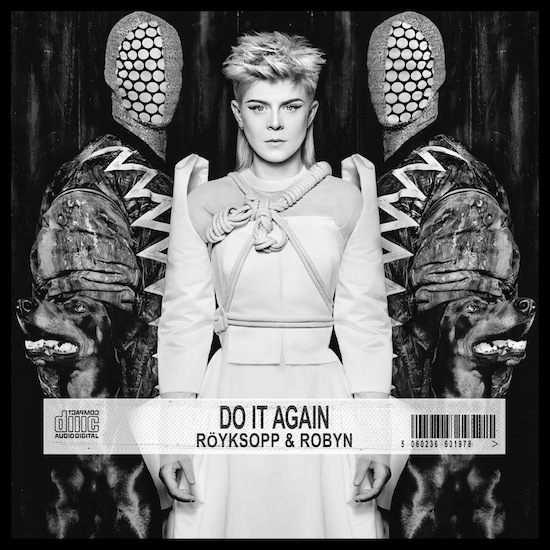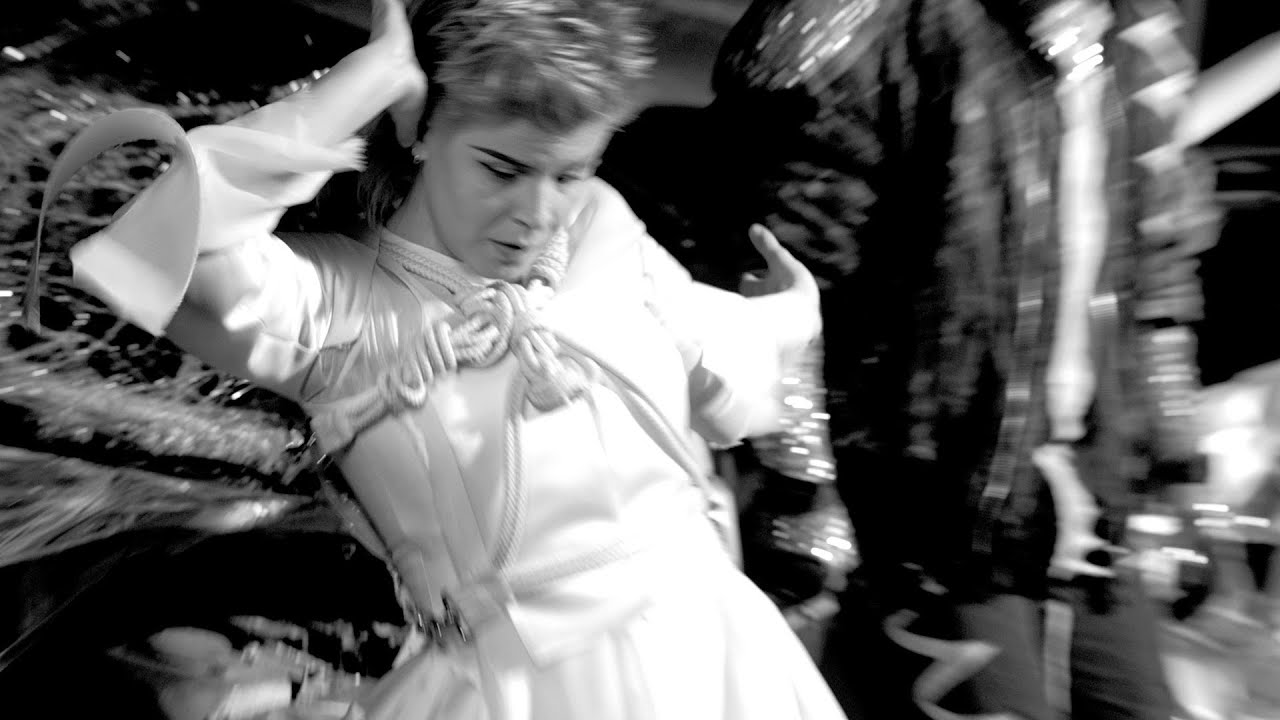Collaborations in music more often than not divide fans; either they love the coming together of two of their favourite artists or they think that one has ruined the others’ credibility. Think Aerosmith and Run-D.M.C., Death In Vegas and Iggy Pop, Aretha Franklin and Eurythmics, David Bowie and Mick Jagger, or more recently, Nile Rodgers and Daft Punk. You will probably have fairly strong feelings about some of those collaborations; the very thought of Bowie and Jagger’s version of ‘Dancing In The Street’, for example, certainly makes my toes curl. However, what I’m sure we can agree on is that the coming together of artists and bands can in some circumstances produce music worth listening to, worth dancing to, worth the collaboration.
Robyn and Röyksopp’s get-together is one of these instances. Having previously worked together on singles ‘The Girl And The Robot’ and ‘None Of Dem’, the trio have got together again for a five track mini-album called Do It Again, out on May 26 via Dog Triumph/Wall Of Sound (stream it in full now at NPR). It will be followed by a tour this summer, with dates on the Do It Again website. The three Scandinavian artists spoke to me about the record, the tour, and why unity, liberty and time are the three words that best describe Do It Again.
What is it about your previous collaborations together that made you want to "do it again" and put out this record?
Svein Berge: Well, we already had that tagline so we were just desperately looking for someone to work with. We needed to do something with someone, we’d already made the T-shirts and the stickers.
Torbjørn Brundtland: We thought, who’s a pushover? Let’s call that blonde Swedish girl.
And what about you, Robyn?
Robyn: [laughs] I just really like working with Svein and Torbjørn, it’s really that simple.
How different is the writing process when working together than when you work on your own projects?
R: It’s different, of course, because there’s more people involved. But for me it doesn’t feel like I have to adapt or change anything when I’m working with them. That’s what’s good about it, we all get to be ourselves.
No compromises that needed to be made?
SB: Well I just want to emphasise that what I said about Robyn earlier was only said because we love working with her. She’s so great in every possible way. But in terms of compromises, one of the reasons that we work so well together is because we all know that we are trying to make the best out of each track. It has nothing to do with ego, or who came up with what. It has to do with, "How can we make it as good as possible?" That’s why we work so well together.
What were you hoping to achieve with this record?
SB: We didn’t have any master plan for what we were doing. Sounding a bit pretentious, this was a free space without any master plan or blueprint for all three of us. We didn’t have any plan other than to hang out, be together and make some music. And we kept it very much between the three of us, without including too many people in terms of labels and management and so on. Which gives you a certain freedom and flexibility. So that was the only sort of thing that we had; have fun, let’s have no inhibitions, no limitations and do whatever we want to do, and that’s why we made a ten-minute track with saxophone.
What was the best part about the recording of this record?
TB: I think what was particularly satisfying was when we talked about how we wanted to include some clipped vocals, that means to cut up vocals. And as we wrote ‘Monument’ we just tried to chop up the "uh, uh, uh, uh, uh" bit and just five minutes earlier we had been talking about it in an abstract way. We thought "that would be cool" and we just did it and it worked. And that’s a good example of our working process. We can fantasise about this or that and sometimes we just go straight ahead and do it.
R: I think that’s why it’s been so fun and why we come back to doing it again, and again and again. No pun intended. I don’t know if you know this feeling but you know when you meet people that you really like and you somehow feel like you can get to the important things really quickly and you don’t have to spend time on things that you don’t think are that important. You can kind of talk about fun stuff and heavy stuff and sad stuff and cool stuff all at the same time and it all feels quite fluid and cool. That’s how it is when we work together.
SB: That is correct. We concur.
Good! It would have been awkward if you didn’t.
SB: Yes. It would have. We’d have been living a lie.
So then what was the worst thing that happened during the recording of the record? Or was it so good that nothing bad happened?
R: Well the three of us each had other things going on in the background that weren’t at all as fun as the things that we were doing in the studio. So the studio was the place where we had fun.
TB: It was an island of merriness.
The record is 35 minutes long and contains five tracks – are there more songs from your sessions together?
R: Yes.
SB: There are songs knocking about out there, yes, indeed.
Any plans to do anything with them?
R: We’ll definitely do something with them, but we don’t know when, or how.
TB: "Do It Again, Again" it will be called.
How important is it to you to perform Do It Again live rather than just keep it as a record?
SB: It’s no secret that after the other tracks that we did together we did a bit of touring together as well. It was a sort of nourishment to this friendship, or whatever you want to call it, this bond that we have. And I think that was a bit of a carrot waiting at the end, the gold at the end of the rainbow; "if we make this record then we can tour with it again".
I’m not too keen on touring anymore, in all honesty, because I’m an old man with back problems. But it makes it a lot more fun and interesting when we have Robyn on board. And it has nothing to do with Torbjørn, the reason I don’t want to tour, it’s just that I’m not too keen on it. But when Robyn’s there it’s a completely different thing.
What can we expect from the upcoming tour? Your website says that there will be a Röyksopp section, a Robyn section, and then a together section. Will this all be one long set or will there be intervals?
R: It’s all a long show.
TB: So one part will be purely Röyksopp material performed by Röyksopp and there’s going to be a Robyn part with Robyn’s stuff performed by Robyn, and then we’ll come out together. And maybe there’ll be breaks to allow you to go to the lobby and buy popcorn and hotdogs.
On the Do It Again website, Robyn, you say that you’re "working on a lot of music at the moment and whatever is finished might be something I put into the set list." Are you any closer to finalising set lists? Will new Robyn or Röyksopp material be heard that’s not from Do It Again?
R: I’m saying that I’m working on other music. So the music you’re going to hear in our set will be all the music we’ve ever made together that’s been released and then who knows? Maybe something else will find its way in there as well. But I don’t think we’ll know anything until we start rehearsals next week.
The tour, while covering a series of cities, only has 15 dates – are there plans to tour the record further? Any dates yet to be announced? Secret shows?
R: Are there any secret shows to announce?
You never know – if I don’t ask then I won’t find out.
TB: I don’t know what to answer to that, but there might be. There might be more. I don’t know how things will pan out. We might be doing more, and we’ll almost certainly be doing the ones that have been announced. That’s the poorest answer I’ve ever given…
The artwork for ‘Do It Again’ features a reworking of the Compact Disc logo – why? What does it mean?
R: I don’t know what that means.
TB: It’s obviously a little nod to that thing [the CD]. From a teen’s point of view that would be considered retro, the CD. For me it’s more of an aesthetic thing than something with any meaning. I think it looks good and that’s really what counts. We’re not fighting for a format that’s dying or saying that the CD is the best thing.
R: It is an era that’s passing. The CD era will be gone soon and it’s fun to look back at that format. It’s always fun to look back at formats but it doesn’t have any deep meaning behind it.
If each of you could choose one word that sums up Do It Again, what would it be?
TB: From a personal point of view I’ll go for the 90s rave word ‘unity’.
SB: For me, I’d have to go back to times of revolution and turmoil and use the word ‘liberty’. For me that refers to the space we created together, how we didn’t have a master plan, we just wanted to make music together. We didn’t think about a target audience or anything like that, we just did it. And that’s the liberty part for me.
R: I think for me it’s probably ‘time’. We dealt with the concept of time on this record.
Royksopp & Robyn play at Sonar Festival, Barcelona, which runs from 12th-14th June –for information and tickets, click here.



